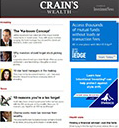
Total plan costs for 401(k) plans dropped to 39 basis points in 2012 vs. 49 basis points in 2009, according to a report Monday from the Investment Company Institute, and BrightScope, a company that evaluates 401(k) plans.
That means the average 401(k) plan participant was paying .39% of his or her portfolio for investment and administrative costs, though the number is heavily weighted by the largest plans, where costs are lowest, because most participants are in those plans.
The decline in expenses — management fees, administrative fees, advice fees and other costs — was felt most strongly by the largest plans and the smallest plans, the report said. For plans with more than $1 billion in assets, the average asset-weighted cost dropped to 28 basis points from 32 basis points during the period, a decline of 12.5%. For plans with less than $1 million in assets, the average cost fell to 164 basis points from 204 basis points, a drop of 19.6%.
Advertisement
Among small plans, “there's been a greater recognition of the importance of fees,” said Sarah Holden, senior director for retirement and investor research at ICI, in an interview. Because small plans have the highest plan costs, they have benefited most from fee reductions, she said.
One possible contributor to lower costs is the growing popularity of index funds. In 2012, index funds accounted for 23.1% of all 401(k) plan assets vs. 16.9% in 2006. The percentage of plans offering index funds increased to 84.2% in 2012 from 77.1% in 2006. This calculation includes mutual funds, collective investment trusts, separate accounts and other pooled investment products, the report said.
Ms. Holden said she couldn't predict how plans would embrace index funds in the future, but she said index funds' growth in the past was based on plan executives' desire to reduce costs and diversify investment menus.
The report also said the amount of assets invested in target-date funds rose to 13.4% in 2012 vs. 3% in 2006. Target-date funds represented the largest percentage of plan assets (22.8%) in 401(k) plans with less than $1 million in total assets. Among the largest plans with more than $1 billion in total assets, target-date funds accounted for 10.3% of assets.
The ICI/BrightScope report was based on an analysis of more than 35,000 plans based on Form 5500 documents filed with the Department of Labor.
Robert Steyer is a reporter at Pensions & Investments, a sister publication.






